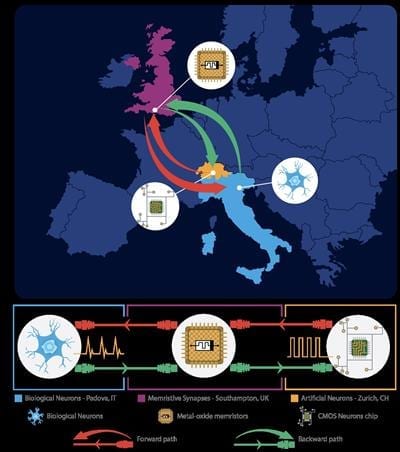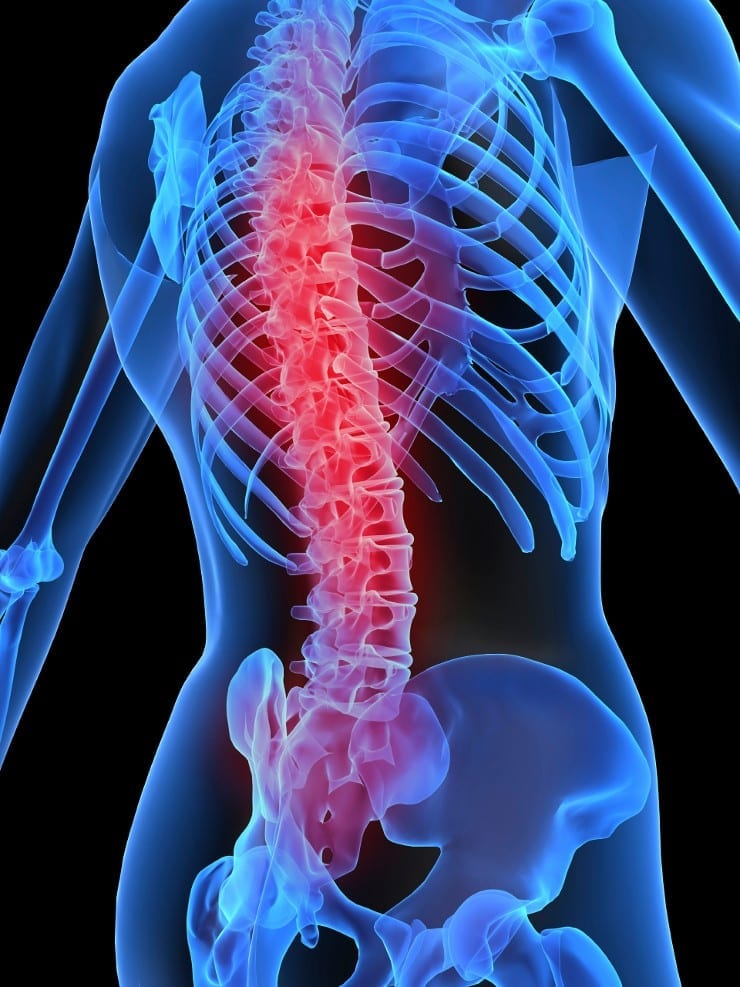
via University of Southampton
Research on novel nanoelectronics devices led by the University of Southampton has enabled brain neurons and artificial neurons to communicate with each other. This study has for the first time shown how three key emerging technologies can work together: brain-computer interfaces, artificial neural networks and advanced memory technologies (also known as memristors). The discovery opens the door to further significant developments in neural and artificial intelligence research.
Brain functions are made possible by circuits of spiking neurons, connected together by microscopic, but highly complex links called ‘synapses’. In this new study, published in the scientific journal Nature Scientific Reports, the scientists created a hybrid neural network where biological and artificial neurons in different parts of the world were able to communicate with each other over the internet through a hub of artificial synapses made using cutting-edge nanotechnology. This is the first time the three components have come together in a unified network.
During the study, researchers based at the University of Padova in Italy cultivated rat neurons in their laboratory, whilst partners from the University of Zurich and ETH Zurich created artificial neurons on Silicon microchips. The virtual laboratory was brought together via an elaborate setup controlling nanoelectronic synapses developed at the University of Southampton. These synaptic devices are known as memristors.
The Southampton based researchers captured spiking events being sent over the internet from the biological neurons in Italy and then distributed them to the memristive synapses. Responses were then sent onward to the artificial neurons in Zurich also in the form of spiking activity. The process simultaneously works in reverse too; from Zurich to Padova. Thus, artificial and biological neurons were able to communicate bidirectionally and in real time.
Themis Prodromakis, Professor of Nanotechnology and Director of the Centre for Electronics Frontiers at the University of Southampton said “One of the biggest challenges in conducting research of this kind and at this level has been integrating such distinct cutting edge technologies and specialist expertise that are not typically found under one roof. By creating a virtual lab we have been able to achieve this.”
The researchers now anticipate that their approach will ignite interest from a range of scientific disciplines and accelerate the pace of innovation and scientific advancement in the field of neural interfaces research. In particular, the ability to seamlessly connect disparate technologies across the globe is a step towards the democratisation of these technologies, removing a significant barrier to collaboration.
Professor Prodromakis added “We are very excited with this new development. On one side it sets the basis for a novel scenario that was never encountered during natural evolution, where biological and artificial neurons are linked together and communicate across global networks; laying the foundations for the Internet of Neuro-electronics. On the other hand, it brings new prospects to neuroprosthetic technologies, paving the way towards research into replacing dysfunctional parts of the brain with AI chips.”
The Latest Updates from Bing News & Google News
Go deeper with Bing News on:
Neuroprosthetic technologies
- Technology News
May 3, 2024 — A stretchy electronic skin could equip robots and other devices with the same softness and touch sensitivity as human skin, opening up new possibilities to perform tasks that ...
- Experimental spinal cord implant helps Parkinson’s patient walk in new study
Marc Gauthier can now step into an elevator without his body stiffening and freezing in place. He can take a 3-mile lakeside stroll without stopping. He can stand up out of a chair with ease. For ...
- Technology & Innovation
Technological innovations have produced robots capable of jobs that, until recently, only humans could perform. The present research explores the psychology of "botsourcing"—the replacement of human ...
- Technology and future of prosthetics focus of conference this weekend in Waterloo region
Technology around prosthetic limbs is getting more sophisticated. New innovations and the future of the industry will be part of a conference happening in Waterloo region Friday and Saturday.
- Technology and the Internet
Randy Travis has released a new song, “Where That Came From,” with the help of artificial intelligence. It’s his first single since he had a stroke.
Go deeper with Google Headlines on:
Neuroprosthetic technologies
[google_news title=”” keyword=”neuroprosthetic technologies” num_posts=”5″ blurb_length=”0″ show_thumb=”left”]
Go deeper with Bing News on:
Internet of Neuro-electronics
- IDKFF ThreeD Capital Inc.
internet of things, electronic sports, junior resources with an emphasis on the precious-metal and battery-metal sectors; artificial intelligence with a focus on disruptive data science ...
- Digi, Nano, Bio, Neuro – or why we should care more about converging technologies
Dirk Helbing expects that in the future digital technologies may penetrate the human body ever more. However, he believes that society is not prepared for the risks. To protect our most intimate data ...
- The Neuro-ophthalmology of Multiple Sclerosis
Neuro-ophthalmologic sequelae are common in MS and may arise from the disease itself or from treatment of the disease. Both afferent and efferent functions may be affected. Despite much progress ...
- Science Friday
Guest host Arielle Duhaime-Ross talks with Jared Genser, general counsel and co-founder of The Neurorights Foundation about the current landscape of neuro ... to plastics and electronic parts.
- Robotic nerve 'cuffs' could help treat a range of neurological conditions
Researchers have developed tiny, flexible devices that can wrap around individual nerve fibers without damaging them. The researchers combined flexible electronics and soft robotics techniques to ...
Go deeper with Google Headlines on:
Internet of Neuro-electronics
[google_news title=”” keyword=”Internet of Neuro-electronics” num_posts=”5″ blurb_length=”0″ show_thumb=”left”]










